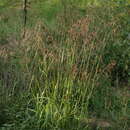Physical Description
provided by USDA PLANTS text
Perennials, Terrestrial, not aquatic, Rhizomes present, Rhizome short and compact, stems close, Stems nodes swollen or brittle, Stems erect or ascending, Stems caespitose, tufted, or clustered, Stems terete, round in cross section, or polygonal, Plants viscid, sticky, glandular-hairy, Stem internodes hollow, Stems with inflorescence less tha n 1 m tall, Stems with inflorescence 1-2 m tall, Stems, culms, or scapes exceeding basal leaves, Leaves mostly basal, below middle of stem, Leaves mostly cauline, Leaves conspicuously 2-ranked, distichous, Leaves sheathing at base, Leaf sheath mostly open, or loose, Leaf sheath smooth, glabrous, Leaf sheath hairy at summit, throat, or collar, Leaf sheath or blade keeled, Leaf sheath and blade differentiated, Leaf blades linear, Leaf blades 2-10 mm wide, Leaf blades mostly flat, Leaf blade margins folded, involute, or conduplicate, Leaf blades mostly glabrous, Leaf blades more or less hairy, Ligule present, Ligule a fringe of hairs, Inflorescence terminal, Inflorescence an open panicle, openly paniculate, branches spreading, Inflorescence solitary, with 1 spike, fascicle, glomerule, head, or cluster per stem or culm, Inflorescence lax, widely spreading, branches drooping, pendulous, Inflorescence curved, twisted or nodding, Inflorescence with 2-10 branches, Inflorescence bra nches more than 10 to numerous, Flowers bisexual, Spikelets laterally compressed, Spikelet less than 3 mm wide, Spikelets with 3-7 florets, Spikelets with 8-40 florets, Spikelets solitary at rachis nodes, Spikelets all alike and fertille, Spikelets bisexual, Spikelets disarticulating above the glumes, glumes persistent, Spikelets disarticulating beneath or between the florets, Rachilla or pedicel glabrous, Glumes present, empty bracts, Glumes 2 clearly present, Glumes equal or subequal, Glumes equal to or longer than adjacent lemma, Glumes keeled or winged, Glumes 1 nerved, Lemmas thin, chartaceous, hyaline, cartilaginous, or membranous, Lemma 3 nerved, Lemma body or surface hairy, Lemma apex dentate, 2-fid, Lemma apex dentate, 3-5 fid, Lemma awnless, Lemma mucronate, very shortly beaked or awned, less than 1-2 mm, Lemma straight, Callus or base of lemma evidently hairy, Callus hairs shorter than lemma, Palea present, well developed, Palea membranous, hyaline, Palea shorter than lemma, Palea about equal to lemma, Palea 2 nerved or 2 keeled, Palea keels winged, scabrous, or ciliate, Stamens 3, Styles 2-fid, deeply 2-branched, Stigmas 2, Fruit - caryopsis.
Tridens flavus: Brief Summary
provided by wikipedia EN
Tridens flavus, the purpletop tridens, red top, or greasegrass, is a large, robust perennial bunchgrass native to eastern North America.
It widespread throughout its range and is most often found in man-made habitats, such as hay meadows and lawns.
The seeds are purple, giving the grass its common name. The seeds are also oily, leading to its other common name, "greasegrass". It reproduces by seed and tillers.
The grass is often confused with the similar looking Johnson grass (Sorghum halepense), although it is only distantly related. Tridens flavus is easily distinguished by its short, hairy ligule.
It is a larval host to the common wood nymph, crossline skipper, little glassywing, and the Zabulon skipper.
- license
- cc-by-sa-3.0
- copyright
- Wikipedia authors and editors

